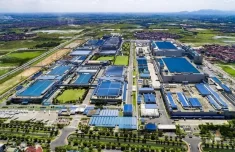
Thus, cumulatively by the end of May 2021, industrial parks and economic zones across the country have 10,853 valid production and business projects of foreign investors with a total registered capital of about 228 million. 4 billion USD, of which realized investment capital reached 69.6%. Along with that, there are 10,186 valid production and business projects of domestic investors with a total registered capital of 2.53 million billion VND, of which realized investment capital is about 45.4%.
According to the Ministry of Planning and Investment, as of May 2021, Vietnam had 394 industrial parks established with a total natural land area of 121.9 thousand hectares. Of which, the industrial land area reached 80.9 thousand hectares, accounting for 66.4% of the natural land area.
Of the 394 established industrial parks, there are 286 industrial parks in operation, these industrial parks have an occupancy rate of 71.8%. Industrial parks across the country have created jobs for 3.78 million direct workers.
The development plan for Vietnam’s coastal economic zones to 2020 and vision to 2030 approved by the Prime Minister includes 19 coastal economic zones with a total area of 871.5 thousand hectares. Of these, 18 economic zones have been established with a total area of 857.6 thousand hectares. One economic zone that has not been established is Ninh Co economic zone, Nam Dinh province with a planned area of 13,950 hectares.
The total area of land leased to implement production investment projects in coastal economic zones is about 44.1 thousand hectares, accounting for 45% of the total land area for industrial production, tourism and services. in the coastal economic zone.
According to the assessment of the Ministry of Planning and Investment, industrial parks and economic zones have contributed positively to economic growth, exports and job creation for workers. However, to improve the operational efficiency of industrial parks and economic zones, it is necessary to promote the integration of industrial park and economic zone planning with social, human resources, land use and urban planning. . In particular, it is necessary to develop industrial parks and economic zones in a sustainable direction, harmonizing industry, urban areas and services, creating links, cooperation, and forming value chains between domestic and foreign businesses.






















